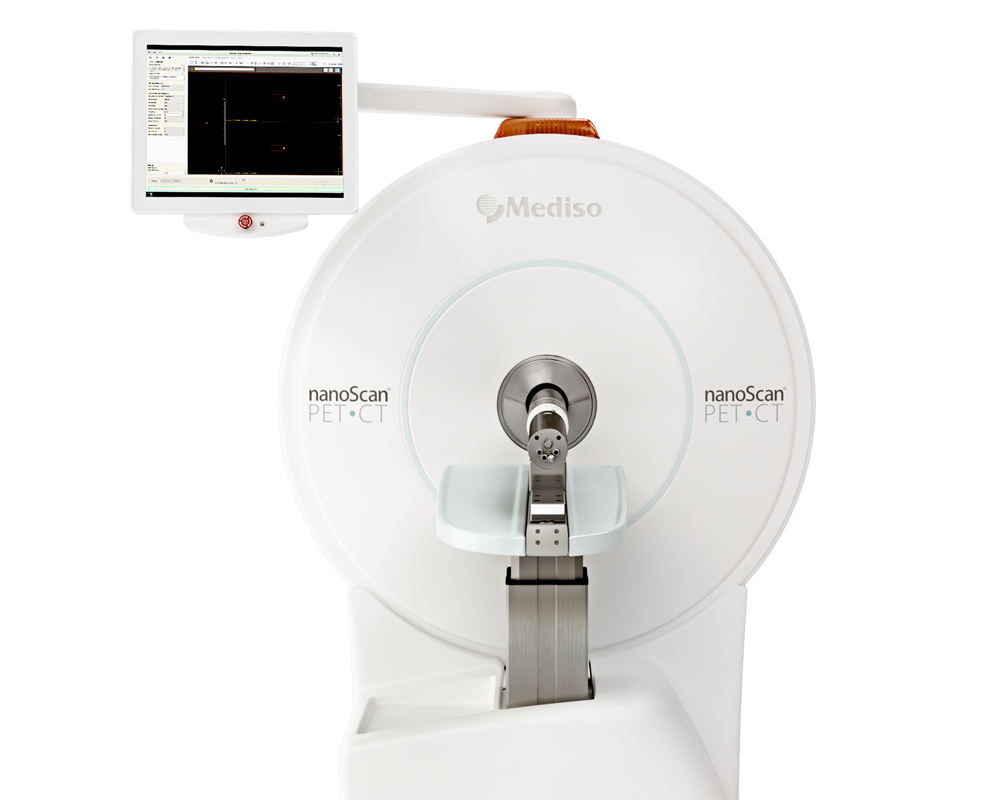A preclinical study on the influence of linkers in [68Ga]Ga-NOTA-X-RM26 radiotracers for PET imaging of GRPR expression
2025.08.07.
Esther Olaniran Håkansson et al, EJNMMI Research, 2025
Summary
Gastrin-releasing peptide receptor (GRPR) is overexpressed in several cancers, including prostate and breast, making it an attractive target for radiopharmaceutical development. Studies on GRPR-targeting radioligands highlight the critical role of the spacer region between the GRPR-recognition motif and radiolabeled moiety, which can significantly influence peptide pharmacokinetics and pharmacodynamics. Herein, we investigated the impact of structurally restricted spacers on the performance of RM26-based radioligands.
Three novel radioligands were designed to each bear a NOTA chelator via different spacers composed of N-acetyl-lysine followed by either o-ethyltoluene (oET), o-methylanisole (oMA), or m-methylanisole (mMA) motifs. The peptides were successfully labeled with Ga-68, achieving high radiochemical yield, purity, and molar activity. The resulting [68Ga]-labeled peptides demonstrated high and GRPR-specific binding to prostate cancer PC-3 cells, antagonistic behavior, and the IC50 values to GRPR were in the single-digit nanomolar range. Biodistribution studies at 2 h post-injection in PC-3 xenograft-bearing mice revealed high, GRPR-mediated tumor uptake for all three radioligands. In addition, high hepatobiliary excretion with elevated uptake in the liver and the gastrointestinal tract and pronounced pancreatic uptake were observed.
Among the three radioligands, the peptide bearing the N-acetyl-lysine-oET spacer exhibited the fastest background clearance and better PET imaging of prostate cancer xenografts. The incorporation of conformationally restricted spacers is a promising strategy for developing tracers with high GRPR binding and good imaging properties, but further optimization is necessary to reduce uptake in healthy tissues.
Results from nanoScan® PET/CT
Female BALB/c nu/nu mice of 18–22 g weight were used in the study. For tumor inoculation, 8x106 PC-3 cells in 100 μL PBS were injected subcutaneously into the right hind leg of mice. Four weeks after tumor cell implantation, mice were randomized and divided into 6 groups (4 animals / group): 3 of them received treatment with 68Ga-radiolabeled peptides, while the other 3 received the same peptides in addition to 5 nmol of non-labeled NOTA-PEG2-RM26 peptide for GRPR-blocking. Peptides were injected intravenously via the tail veins at a dose of 50 pmol (700 kBq radioactivity dose).
At 2 h post injection, mice were sacrificed by overdose of Ketamine/Xylazine anesthesia, and blood was collected by heart puncture. Then, liver, spleen, lungs, pancreas, kidneys, small intestine, stomach, tail, femur bones, tumor and muscle from the opposite legs were collected, weighed, and radioactivity was measured using a Wizard 2480 gamma counter.
For PET/CT imaging, animals bearing PC-3 xenografts were used. The animals received a single intravenous injection of the corresponding 68Ga-radiolabeled peptide (100 pmol, 1.2 MBq). For image acquisition, NanoScan PET/MRI 3T and nanoScan SPECT/CT were used. Reconstruction of the PET scans was conducted using Nucline nanoScan 3.04.014.0000 software. CT data were reconstructed using Filter Back Projection in Nucline Software. PET images are presented as maximum intensity projections (MIP) with an equivalent color scale.
Results show:
- The peptides demonstrated rapid whole-body clearance and excretion. This demonstrates the high stability of 68Ga-labeled conjugates in vivo, which did not undergo radionuclide exchange with blood proteins.
- The highest activity uptake was observed in the pancreas and in tumors, which correlates well with high GRPR expression in these tissues.
- The oMA peptide demonstrated at least a 1.7-fold higher accumulation in the pancreas, compared to other peptides. Tumor activity uptake was similar among the three compounds.
- The activity uptake was GRPR-specific and could be blocked by co-injection of a 100-fold dose of non-labelled NOTA-PEG2-RM26 peptide. Furthermore, receptor blocking decreased radionuclide accumulation in the pancreas and tumor by an order of magnitude. Blocking also decreased peptide uptake in the stomach and small intestine, which have moderate GRPR expression in mammals
- The moderate activity uptake in the kidney was non-GRPR specific and indicates participation of renal clearance in peptide elimination. Additionally, we observed moderate peptide accumulation in the liver and lungs, likely due to off-target interactions with other receptors or plasma proteins. Interestingly, the oET peptide had the lowest activity uptake in these tissues.
- All 3 compounds demonstrated similar levels of activity uptake in tumors (Fig. 3).
- The best tumor-to-liver ratio was found for oET peptide, due to low activity accumulation in the liver. The tumor-to-muscle, tumor-to-blood and tumor-to-bone ratios indicated that high contrast image could be obtained already 2 h pi.

Fig. 3 (a-c) Biodistribution and specificity of 68Ga-labeled oET (a), oMA (b), mMA (c) peptides. Blockade was induced by co-injection of 100-fold excess of NOTA-PEG2-RM26 GRPR-binding peptide. (d) Tumor-to-tissues ratios of the activity accumulation for oET, oMA, mMA peptides. Data are presented as mean ± SD.
- PET/CT images of mice bearing PC-3 xenografts were acquired 2 h post injection (Fig. 4). The PET images were in accordance with the biodistribution data. All the radioligands demonstrated accumulation in GRPR-expressing PC-3 tumors, and mMA compound showed a lower uptake compared to the oET and oMA analogs. The radioligands also had activity accumulation in abdominal tissues, kidneys, and liver. The oET tracer demonstrated the lowest signal in the liver area on PET images, and the 68Ga-radiolabeled oET and oMA peptides enable clear identification of the tumor sites.

Fig. 4 PET/CT scans of (a) [68Ga]Ga-NOTA-oET-RM26, (b) [68Ga]Ga-NOTA-oMA-RM26 and (c) [68Ga]Ga-NOTA-mMA-RM26. Images are presented in maximal intensity of full body projections on the same scale (minimum: 0 kBq/mL, maximum: 240 kBq/mL).
In summary, biodistribution studies in mice bearing human xenografts, along with PET imaging, indicated that the compound with the intermediate lipophilicity, oET, holds promise for further clinical evaluation. Biodistribution studies in mice bearing human xenografts, along with PET imaging, indicated that the compound with the intermediate lipophilicity, oET, holds promise for further clinical evaluation.
Ful article on ejnmmires.springeropen.com
How can we help you?
Don't hesitate to contact us for technical information or to find out more about our products and services.
Get in touch
